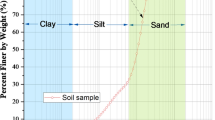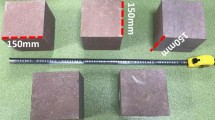Abstract
Based on the Brazilian test results of 23 kinds of transversely isotropic rocks, five trends are obtained for the variation of normalized failure strength (NFS) as a function of the weak plane-loading angles. For each angle, three kinds of fracture patterns are obtained. Furthermore, a new numerical approach based on the particle discrete element method is put forward to systematically investigate the influence of the micro-structure of rock matrix and strength of weak plane on NFS and fracture patterns. The results reveal that the trend of NFS and fracture patterns are slightly influenced by coordination number of rock particles and tensile strength of weak plane, but greatly influenced by percentage of pre-existing cracks and shear strength of weak plane. Micro-parameters of the numerical approach are calibrated to reproduce behaviours of transversely isotropic rocks with different trends, and the simulation results are well matched with experimental results in terms of NFS and fracture patterns. Finally, the numerical approach is applied to study the failure process of layered surrounding rock after tunnel excavation. The simulation results also agree well with observation results of engineering projects.





















Similar content being viewed by others
References
Amadei B (1996) Importance of anisotropy when estimating and measuring in situ stresses in rock. Int J Rock Mech Min Sci Geomech Abstr 33:293–325
Bahaaddinia M, Sharrocka G, Hebblewhitea BK (2013) Numerical investigation of the effect of joint geometrical parameters on the mechanical properties of a non-persistent jointed rock mass under uniaxial compression. Comput Geotech 49:206–255
Bahaaddinia M, Sharrocka G, Hebblewhitea BK (2013) Numerical direct shear tests to model the shear behaviour of rock joints. Comput Geotech 51:101–115
Barla G, Innaurato N (1973) Indirect tensile testing of anisotropic rocks. Rock Mech 5:215–230
Bennett KC, Berla LA, Nix WD, Borja RI (2015) Instrumented nanoindentation and 3D mechanistic modeling of a shale at multiple scales. Acta Geotech 10:1–14
Blümling P, Bernier F, Lebon P, Martin CD (2007) The excavation damaged zone in clay formations time-dependent behavior and influence on performance assessment. Phys Chem Earth 32:588–599
Brown ET, Green SJ, Sinha KP (1981) The influence of rock anisotropy on hole deviation in rotary drilling—a review. Int J Rock Mech Min Sci Geomech Abstr 18:387–401
Chen CS, Pan E, Amadei B (1998) Determination of deformability and tensile strength of anisotropic rock using Brazilian tests. Int J Rock Mech Min Sci 35:43–61
Cho JW, Kim H, Jeon SK, Min KB (2012) Deformation and strength anisotropy of Asan gneiss, Boryeong shale, and Yeoncheon schist. Int J Rock Mech Min Sci 50:158–169
Chong ZH, Li XH, Hou P et al (2017) Numerical investigation of bedding plane parameters of transversely isotropic shale. Rock Mech Rock Eng 50:1183–1204
Dan DQ (2011) Brazilian test on anisotropic rocks- laboratory experiment, numerical simulation and interpretation. Dissertation, Freiberg University of Technology
Debecker B (2009) Influence of planar heterogeneities on the fracture behavior of rock. Dissertation, University of Leuven
Duan K, Kwok CY (2015) Discrete element modeling of anisotropic rock under Brazilian test conditions. Int J Rock Mech Min Sci 78:45–56
Everitt RA, Lajtai EZ (2004) The influence of rock fabric on excavation damage in the Lac du Bonnett granite. Int J Rock Mech Min Sci 41:1277–1303
Fortsakis P, Nikas K, Marinos V, Marinos P (2012) Anisotropic behaviour of stratified rock masses in tunnelling. Eng Geol 141:74–83
Gholamreza K, Behruz R, Yasin A (2015) An experimental investigation of the Brazilian tensile strength and failure patterns of laminated sandstones. Rock Mech Rock Eng 48:843–852
Gong QM, Zhao J, Jiao YY (2005) Numerical modeling of the effects of joint orientation on rock fragmentation by TBM cutters. Tunn Undergr Space Technol 20:183–191
Hakala M, Kuula H, Hudson JA (2007) Rock properties for in situ stress measurement data reduction: a case study of the Olkiluoto mica gneiss, Finland. Int J Rock Mech Min Sci 44:14–46
Hornby BE, Schwartz LM, Hudson JA (1994) Anisotropic effective-medium modelling of the elastic properties of shales. Geophysics 59:1570–1583
Hou P, Gao F, Yang YG, Zhang ZZ, Zhang XX (2016) Effect of layer orientation on the failure of block shale under Brazilian splitting test and energy analysis. Chin J Geotech Eng 38:930–937 (in Chinese)
Indraratna B, Ngo NT, Rujikiatkamjorn C, Sloan SW (2015) Coupled discrete element–finite difference method for analysing the load-deformation behaviour of a single stone column in soft soil. Comput Geotech 63:267–278
Itasca Consulting Group (2008) Particle flow code in 2 dimensions user’s guide. Itasca Consulting Group Inc, Minneapolis, USA
Kim H, Cho JW, Song I, Min KB (2012) Anisotropy of elastic moduli, P-wave velocities, and thermal conductivities of Asan gneiss, Boryeong shale, and Yeoncheon schist in Korea. Eng Geol 148:68–77
Kim KY, Zhuang L, Yang H et al (2016) Strength anisotropy of Berea sandstone: results of X-Ray computed tomography, compression tests, and discrete modeling. Rock Mech Rock Eng 49:1201–1210
Li DY, Wong LNY (2013) The Brazilian disc test for rock mechanics applications: review and new insights. Rock Mech Rock Eng 46:269–287
Li LC, Meng QM, Wang SY et al (2013) A numerical investigation of the hydraulic fracturing behaviour of conglomerate in Glutenite formation. Acta Geotech 8:597–618
Lisjak A, Grasselli G, Vietor T (2014) Continuum–discontinuum analysis of failure mechanisms around unsupported circular excavations in anisotropic clay shales. Int J Rock Mech Min Sci 65:96–115
Liu YS (2013) Brazilian splitting test theory and engineering application for transversely isotropic rock. Dissertation, Central South University (in Chinese)
Liu F, Gordon PA, Valiveti DM (2017) Modeling competing hydraulic fracture propagation with the extended finite element method. Acta Geotech, pp 1–23. https://doi.org/10.1007/s11440-017-0569-6
Marschall P, Distinguin M, Shao H, Bossart P, Enachescu C, Trick T (2006) Creation and evolution of damage zones around a microtunnel in a claystone formation of the Swiss Jura Mountains. In: Proceedings of the international symposium and exhibition on formation damage control, Lafayette, pp 95–110
Park B, Min KB (2015) Bonded-particle discrete element modeling of mechanical behavior of transversely isotropic rock. Int J Rock Mech Min Sci 76:243–255
Potyondy DO (2012) PFC 2D flat joint contact model. Itasca Consulting Group Inc, Minneapolis
Potyondy DO (2015) The bonded-particle model as a tool for rock mechanics research and application: current trends and future directions. Geosyst Eng 18:1–28
Potyondy DO, Cundall PA (2004) A bonded-particle model for rock. Int J Rock Mech Min Sci 41:1329–1364
Roy DG, Singh TN (2016) Effect of heat treatment and layer orientation on the tensile strength of a crystalline rock under Brazilian test condition. Rock Mech Rock Eng 49:1–15
Sanio HP (1985) Prediction of the performance of disc cutters in anisotropic rock. Int J Rock Mech Min Sci Geomech Abstr 22:153–161
Semnani SJ, Borja RI (2017) Quantifying the heterogeneity of shale through statistical combination of imaging across scales. Acta Geotech 12:1193–1205
Semnani SJ, White JA, Borja RI (2016) Thermoplasticity and strain localization in transversely isotropic materials based on anisotropic critical state plasticity. Int J Numer Anal Methods Geomech 40:2423–2449
Tan X, Heinz K, Thomas F, Dan DQ (2015) Brazilian tests on isotropic transversely isotropic rocks: laboratory testing and numerical simulations. Rock Mech Rock Eng 48:1341–1351
Tavallali A, Vervoort A (2010) Effect of layer orientation on the failure of layered sandstone under Brazilian test conditions. Int J Rock Mech Min Sci 47:313–322
Tjioe M, Borja RI (2015) On the pore-scale mechanisms leading to brittle and ductile deformation behavior of crystalline rocks. Int J Numer Anal Methods Geomech 39:1165–1187
Tjioe M, Borja RI (2016) Pore-scale modeling of deformation and shear band bifurcation in porous crystalline rocks. Int J Numer Methods Eng 108:183–212
Vervoort A, Min KB, Konietzky H et al (2014) Failure of transversely isotropic rock under Brazilian test conditions. Int J Rock Mech Min Sci 70:343–352
Wang PT, Cai MF, Ren FH (2018) Anisotropy and directionality of tensile behaviours of a jointed rock mass subjected to numerical Brazilian tests. Tunn Undergr Space Technol 73:139–153
Wu SC, Xu XL (2016) A study of three intrinsic problems of the classic discrete element method using flat-joint model. Rock Mech Rock Eng 49:1813–1830
Xu GW (2017) Stability analysis of tunnels in layered phyllite stratum. Dissertation, Southwest Jiaotong University (in Chinese)
Eshiet KII, Sheng Y (2016) The role of rock joint frictional strength in the containment of fracture propagation. Acta Geotech 12:897–920
Yang ZP, He B, Xie LZ, Li CB, Wang J (2015) Strength and failure modes of shale based on Brazilian test. Rock Soil Mech 36:3447–3464 (in Chinese)
Yang XX, Kulatilakeb PHSW, Jing HW, Yang SQ (2015) Numerical simulation of a jointed rock block mechanical behavior adjacent to an underground excavation and comparison with physical model test results. Tunn Undergr Space Technol 50:129–142
Zhang Q (2013) Modification of generalized 3D Hoke-Brown rock masses strength criterion and its parameters multi-scale studies. Tongji University, Shanghai
Zhang F, Dontsov E, Mack M (2017) Fully coupled simulation of a hydraulic fracture interacting with natural fractures with a hybrid discrete-continuum method. Int J Numer Anal Methods Geomech 41:1430–1452
Acknowledgements
This research was supported by the National key research and development program of China (Grant No. 2016YFC0802201).
Author information
Authors and Affiliations
Corresponding author
Rights and permissions
About this article
Cite this article
Xu, G., He, C., Chen, Z. et al. Effects of the micro-structure and micro-parameters on the mechanical behaviour of transversely isotropic rock in Brazilian tests. Acta Geotech. 13, 887–910 (2018). https://doi.org/10.1007/s11440-018-0636-7
Received:
Accepted:
Published:
Issue Date:
DOI: https://doi.org/10.1007/s11440-018-0636-7




